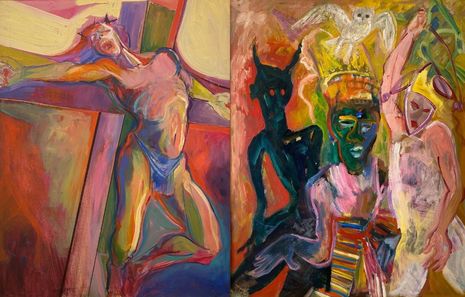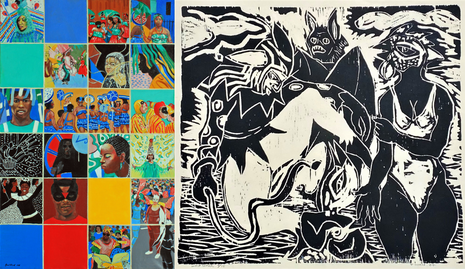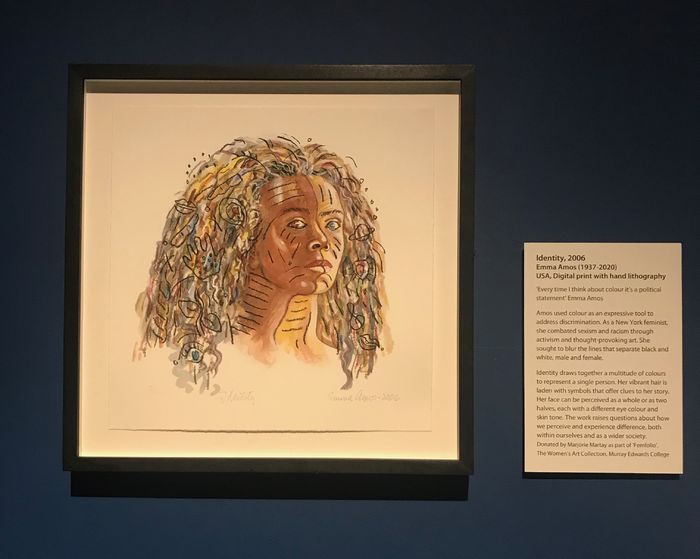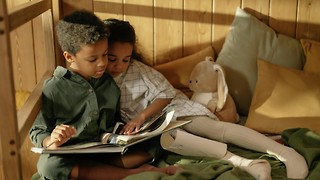Paint Like the Swallow Sings Calypso exhibition reveals how carnival is a universal human experience
Kettle’s Yard gallery’s latest exhibition is an eye-catching exploration of how the many different forms of carnival can also unite us together

Paint Like the Swallow Sings Calypso is the first exhibition Kettle’s Yard Gallery has presented with pieces from the Fitzwilliam Museum collection. Impressions of carnival by Paul Dash, Errol Lloyd and John Lyons are thoughtfully juxtaposed with European masterpieces spanning back to the 16th century to create a wonderfully unmissable exhibit.
‘Carnival has no boundary’
Curator Habda Rashid fondly refers to John, Paul and Errol as her “rock band” discussing how they rebelliously, “show that carnival has no boundary.” She explains that while John’s work focuses on folkloric and spiritual associations connected to carnival from around the globe, Paul, who came from Barbados to the UK in the 1960s, preserves his memories of carnival through dynamic cross-hatched work. Errol, on the other hand, documents and merges the images of his first experiences of carnival as he witnessed them in Notting Hill. In a video interview, Errol Lloyd says that few works from the Kettle’s Yard and the Fitzwilliam collections resonate with carnival. Most of the choices from the Fitzwilliam date back to the 16th century. The paintings coming from the Kettle’s Yard collection have a broader connection to carnival, particularly through their colour, dynamic composition, and movement. Errol Lloyd says this is what the team collectively defined as the essence of carnival.

On the ground floor, the rich body of work consists of two parts. In the first room, we see etchings and drawings from the Fitzwilliam collection alongside Paul Dash’s mixed media work which stand, according to Rashid, on the line “between representation and abstraction.” Welcoming us with Dash’s colourful Bacchanal, and then turning to Giulio Carpioni’s Bacchanal with Satyr and Putti (c. 1650), this room is concerned with the history and ancestry of carnival and connects the concept to European Catholic tradition. We are invited to compare Breugel’s joyous ordinary people with Goya’s rendering of the hypocrisy of Spanish high society. And then asked to contrast this with Paul Dash’s contemporary work which pictures Carnival as “the voice of freedom by African diaspora people alongside other marginalised peoples in the Americas” and a “treat for the senses”. Looking up from this visual discourse, we read the powerful words of Wilson Harris, an eminent writer of the CAM (The Caribbean Artist Movement): “How to perceive the morality of Carnival without a universal plaque of violence!”
The director of Kettle’s Yard, Andrew Nairne, told me that the exhibition operates on many levels: art, words, and the connections between all the worlds we enter through this selection. I found that to be particularly true in the second room, where John Lyons and Errol Lloyd show us that carnival has no boundaries. From the religious to the profane; from mythology, nature, and animals, to a blue-and-yellow large-scale abstraction, this room allows for a variety of expressions which underline the communal experience of carnival.
I left with the feeling that carnival is a human, universal thing, and I found my own place in it too
In the Research Room on Floor 1, visitors can learn more about this exhibition by watching interviews with all three artists, seeing their sketchbooks, and browsing through academic materials. For me, the message of the exhibition can only be revealed by considering curator Habda Rashid’s multidisciplinary approach which she hopes will give people “the ability to make unique connections” and to “form their carnival sensibility.” When I asked John Lyons about his attitude towards art as a language, he said, “art for me is a language. It has its syntax. Not a spoken, but a visual language, built on line, shape, colour, texture.”
I certainly left with the feeling that carnival is a human, universal thing, and I found my place in it, too. The busy pallet of Paul Dash’s Carnival Dancers Mingle challenged me to refresh my memories of Vladimir Dimitrov’s paintings of Bulgarians picking fruit in traditional folk clothing. A quick search then tells me that my home country’s St Trifon Zarezan’s Day, celebrating the fecundity of the grape season with rituals, dances and wine, unites my country’s Christian Orthodox present and its pagan past, much like carnival is inspired by both its Catholic origins and the Roman Bacchanalia.
The possibilities of carnival are endless, and so are the possibilities of interpretation in this eye-catching exhibition. Carnival can be about the dress, power play, a release of energy, and indulgence. It can be a form of expression, claiming space, reconnecting to or sharing one’s culture, celebrating natural and religious cycles… It is a way of seeing past our differences and into what binds us all in the universal human experience.
The exhibition lasts until 19 February, so be sure to visit before then. You might even consider taking one of the visitors’ suggestions and choosing to walk through the halls with the tunes of Calypso king, Mighty Swallow, in your earbuds. I have no doubt that this experience would be powerful.
 News / Cambridge launches plan to bridge ‘town and gown’ divide27 October 2025
News / Cambridge launches plan to bridge ‘town and gown’ divide27 October 2025 News / Uni offers students £55k in payouts31 October 2025
News / Uni offers students £55k in payouts31 October 2025 News / Students launch women’s society excluding trans women31 October 2025
News / Students launch women’s society excluding trans women31 October 2025 Arts / Reflections on the Booker Prize 202528 October 2025
Arts / Reflections on the Booker Prize 202528 October 2025 News / College rowing captains narrowly vote to exclude trans women31 October 2025
News / College rowing captains narrowly vote to exclude trans women31 October 2025










